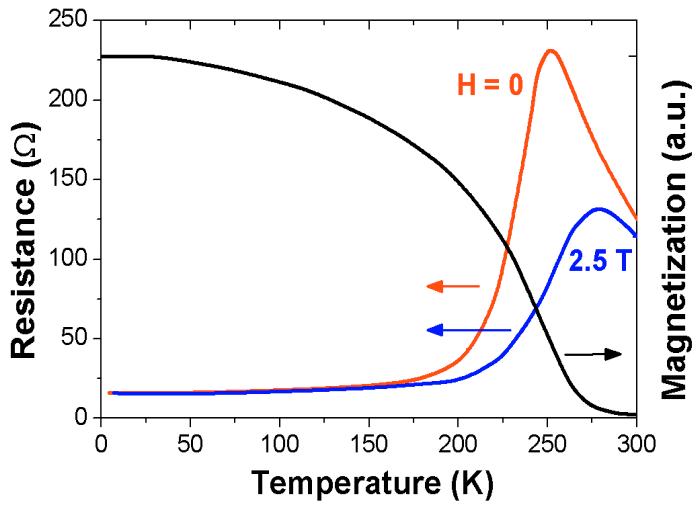
Mixed valence manganese oxides R1-xAxMnO3 (R = rare-earth cation, A = alkali or alkaline earth cation) have
been heavily investigated in recent years [see review by Coey, Viret and von Molnár,
Advances in Physics 48 (1999) 167]. These materials show a variety of interesting
crystallographic, electronic and magnetic properties and phases. Their extraordinary
properties led to the development of new physical concepts such as double exchange and
the Jahn-Teller polaron in the 1950's and 60's.
In the 1990's renewed interest in these materials awoke when new phenomena as, e.g, the
colossal magnetoresistance near the Curie temperature or electronic phase separation, were
found in thin films.
In the parent compound, LaMnO3 (insulating antiferromagnet, superexchange), Mn is in a 3+ valence state. Upon doping by a divalent element (Ca2+, Sr2+, Ba2+, Pb2+) the Mn is driven into a mixed valence state Mn3+/Mn4+. For appropriate doping the ground state of the material is aferromagnetic metal with the transport properties governed by double exchange. It is one of our main results that there is a surprising similarity between divalent and tetravalent doping leading to a Mn3+/Mn4+ and Mn2+/Mn3+ mixed valency, respectively.
Energy can be gained by a small lattice distortion in case of the Mn3+. Here, one electron with dz2 orbital occupies the two eg states (this may lead to charge and orbital ordering for certain doping). In the other cases, there is either no electron (Mn4+) or two electrons (Mn2+) in the eg states with no Jahn-Teller distortion.
The manganites show a high degree of spin polarization at EF making them suitable for innovative device concepts. Early spin-resolved photoemission measurements on La0.7Sr0.3MnO3 [J.-H. Park et al., Nature 392 (1998) 794] showed a nearly complete spin polarization. However, point contact Andreev reflection measurements gave about 73% spin polarization for La0.7Sr0.3MnO3, in agreement with the finding of minority spin carriers by tunneling experiments using a superconducting electrode [Worledge et al., 2000] and band structure calculations [Pickett and Singh, 1996].
There is growing evidence for phase separation in the hole doped manganites: an electrically
well conducting phase can coexist on a nanometer scale with a second phase of lesser
conductivity in chemically homogeneous material [E. Dagotto, T. Hotta and A. Moreo,
Phys. Reports 344 (2001) 1]. Within this scenario the metal-insulator-transition
can be described by percolation assuming a spacial growth of the conducting phase for
decreasing temperature. If regions of this pahse overlap a continuous current may form
resulting in a sudden drop of the resistivity. It is believed that this phenomenon relies
on the similarity of the relevant energy scales in the manganites.
The percolative behavior in hole doped manganites could be demonstrated by noise
measurements: noise is enhanced close to the percolation threshold [29]. A more direct method to visualize the phase separation
is Scanning Tunneling Microscopy [M. Fäth et al., Science
285 (1999) 1540; T. Becker et al., Phys. Rev. Lett. 89 (2002) 237203].
Early magnetization measurements (started by Wollan and Koehler 1955) showed that the
spin-only ferromagnetic moment of Mn is rarely attained. Several explanations were
subsequently given: a canted or spiral spin structure, magnetic inhomogeneities and
disorder on the A-site sublattice. The conduction electrons should be highly spin
polrized due to the double-exchange mechanism in which the eg electrons of Mn3+ are
delocalized and interact with the localized Mn4+
spins.
We performed magnetization measurements on manganites (R0.7A0.3)MnO3 with R = La3+, Pr3+, Nd3+ and A = Ca2+, Sr2+, Ba2+, Pb2+ in high magnetic
fields (up to 25 T) [23]. Only for La0.7Sr0.3)MnO3 a negligible high
field slope of the B(H)-curves was found, i.e. the ground state of this compound
is a fully aligned ferromagnet, in agreement with other measurements. For the other
La-compounds, the high-field slopes (0.1 - 10 × 10-3
μB, typical for weak ferromagnetism) and the
reduced saturation magnetization point towards a cation deficiency.
(Pr0.7Ca0.3)MnO3 does not appear to
be ferromagnetic in its ground state but shows two first-order magnetization processes
[23]. The first one (at around 5 T) leads from an
insulating, canted antiferromagnetic to the metallic, ferromagnetic, charge disordered
state. The second transition is likely a crossing of the Pr crystal field levels. The Nd
compounds appear to be charge ordered.
For (Nd0.7Ca0.3)MnO3, there is an
insulating, nonferromagnetic ground state. The transition to ferromagnetism is associated
with a melting of local charge order of the Mn ions. For this compound, the transition
is strongly temperature and sweep-rate dependent [P1].
Assuming a thermally activated process for the melting / freezing of the charge ordered state we found an activation
energy of 130 K. The thermal activation involves clusters of about 8 Mn ions in size.